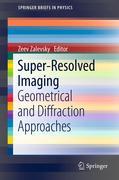
In this brief we review several approaches that provide super resolved imaging, overcoming the geometrical limitation of the detector as well as the diffraction effects set by the F number of the imaging lens. In order to obtain the super resolved enhancement, we use spatially non-uniform and/or random transmission structures to encode the image or the aperture planes. The desired resolution enhanced images are obtained by post-processing decoding of the captureddata. Dr. Zalevsky, the editor of the brief, is well respected in his field. Several super resolved imaging approaches are reviewed. INDICE: Preface. Contents. Chapter One. 1.1 Fourier Optics. 1.1.1 Free Space propagation: Fresnel & Fraunhofer integrals. 1.1.2 Imaging system. 1.2: Diffraction Resolution limitation. 1.3: Geometrical Resolution limitation. The effects of sampling by CCD (pixel shape & aliasing). 1.4 Super-resolution explained by Degrees of freedom number. 1.5 Inverse problem statement of super-resolution. References. Chapter 2. 2.1 Single snap-shot double field optical zoom. 2.1.1 Introduction. 2.1.2 Theory. 2.1.3. Simulation Investigation. 2.2 Full Field of View Super-resolution Imaging based on Two Static Gratings and White Light Illumination. 2.2.1 Introduction. 2.2.2 Mathematical Analysis. 2.2.3 Experimental Results. 2.3 Super-resolution using gray level coding. 2.3.1 Introduction. 2.3.2 Theory. 2.3.3 Experiment. References. Chapter 3. 3.1 Geometrical Super Resolution Using Code Division Multiplexing. 3.1.1 Introduction. 3.1.2 Theoretical Analysis. 3.1.3 Computer Simulations. 3.1.4 Experimental Results. 3.2Diffraction Super Resolution Using Code Division Multiplexing. 3.2.1 Introduction. 3.2.2 Theoretical Analysis. 3.2.3 Computer Simulations. 3.2.4 Experimental Results. References. Chapter 4. 4.1 Geometrical Super Resolved Imaging Using Non periodic Spatial Masking. 4.1.1 Introduction. 4.1.2 Theoretical Analysis. 4.1.3 Experimental investigation. 4.2 Random angular coding for super-resolved imaging. 4.2.1 Introduction. 4.2.2 Mathematical Derivation. 4.2.3. Numerical Simulation of the System. 4.2.4. Experimental results. References.
- ISBN: 978-1-4614-0832-1
- Editorial: Springer New York
- Encuadernacion: Rústica
- Páginas: 116
- Fecha Publicación: 28/09/2011
- Nº Volúmenes: 1
- Idioma: Inglés
